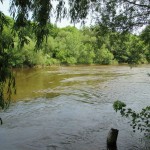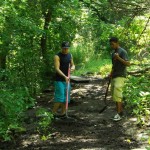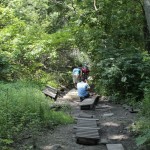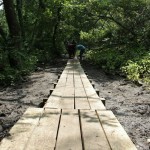While walking the trail on the west bank of the Milwaukee River, between Capital Drive and Locust Street in Riverwest, Julia Kirchner ran into a representative of the Milwaukee River Advocates Cooperative – a group whose mission is to preserve and renew the natural habitat of the Milwaukee River. They began talking, and soon enough, decided to collaborate.
Kirchner teaches “Building Community” at MIAD, one of the college’s Service Learning courses. MIAD is located right along the Milwaukee River – the same river that flows past the trail on which Kirchner had recently been walking. Between these two points, however, the river changes dramatically. The view from MIAD is quite polluted. Seeing this connection as an opportunity to learn about the interaction between Milwaukee’s natural and built environments, Kirchner integrated it with her course. Students this summer would be outside and engaged with the world.
Once the class started up in early June, Kirchner led students on trips to the trail by the Milwaukee River, where they met with Milwaukee River Advocates representatives David and Petra Press. The Milwaukee River Advocates Cooperative arose to address issues surrounding the health and survival of the river environment. The area is a wildlife corridor and important green space that they are trying to protect from urban encroachment. Wildlife corridors connect sections of a habitat that have been fragmented by human activity. This allows for the movement of species, which cultivates diversity and reduces the odds of such species becoming endangered or extinct (“Corridor Science,” “Our Work to Build Corridors for Wildlife”).
It goes without saying that when we degrade or overuse the environment we are destroying the natural resources on which we rely. There is also significant research, however, on the positive impact of natural or “green” landscapes on human health. Studies show that the proper green residential landscaping can actually reduce crime and strengthen communities, as well as promote their overall wellbeing. Research completed through the Landscape and Human Health Laboratory at the University of Illinois, Urbana Champaign, compared residential areas with trees and other greenery to those in a more or less barren landscape. The results have demonstrated that green environments have a relaxing effect on mood, they bring people together outdoors, and that a green and well-kept apartment exterior, for example, communicates to potential criminals that owners and residents care for and watch over the property and one another.
Through the discussion of these and other ideas, as well as direct observation of the Milwaukee River and trail, the group came to a decision on plans to benefit the river environment. The main project was a boardwalk that would run the length of a portion of the unpaved trail that is particularly muddy due to natural springs. This would protect the high-traffic area from damage and at the same time keep hikers and bicyclists from getting stuck in the mud. Along with the construction of the boardwalk, students also took photographs of animals, plants, and the river environment that will be used to update the Milwaukee River Advocates brochure and in other educational and publicity materials. One student did extensive work on updating and repairing their website, where some of the photographs will also be used. Although students were able to contribute knowledge and skills from their own respective areas of expertise (including, but not limited to Photography, Industrial Design, Communication Design, and Illustration), all students were able to participate in all aspects of the undertaking.
After much hard work, the project has recently been brought to completion. The endeavor has allowed the students in this course to put their creative skillsets to work in a context outside of school, providing them crucial professional and life experience. With the emphasis on Kirchner’s course topic of community building, the experience has also doubled as an embodied example of how members of a community can come together to achieve a common purpose.
Kirchner explained that as citizens we have the “constitutional right to freedom of assembly, but what many people don’t see is that we need public spaces in order to assemble… Green spaces such as parks are great for this,” she says. “For example, you see people from all walks of life on the trail.”
Photo Gallery
- The Milwaukee River by MIAD.
- View of the Milwaukee River from the trail in Riverwest.
- Panorama of trees hanging over the Milwaukee River.
- Bullfrog in River
- Bumble Bee on Red Clover
- White-tailed Deer
- Cooper’s Hawk perches on a branch.
- Virginia Waterleaf
- Red Admiral Butterfly
- Class discusses plans with David Press.
- Examining the trail.
- The old boardwalk is moved further down the trail.
- Preparing the area for construction of the boardwalk.
- The old boardwalk and the new.
- Students gather wood to take down to the trail.
- Student assembles pieces of the boardwalk.
- Students lay down the framework of the boardwalk.
- Student drills boards into place.
- Placing some of the final planks of wood.
- Class comes together after much hard work.
- The team and their accomplishment.
- The new boardwalk is put to use!
*All photos taken by “Building Community” participants
For more information on this project, to view the refurbished website, or to learn more about the Milwaukee River Advocates Cooperative, please visit www.milwaukeeriveradvocates.org.
Works Cited:
“Corridor Science.” Conservation Corridor. Conservation Corridor, 2013. Web. 21 July 2014.
“Our Work to Build Corridors for Wildlife.” National Wildlife Federation. National Wildlife Federation, 2014. Web. 21 July 2014.
University of Illinois at Urbana Champaign: Landscape and Human Health Laboratory. University of Illinois Urbana Champaign, n.d. Web. 21 July 2014.





















